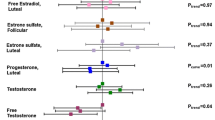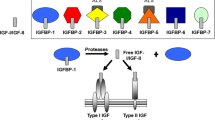Abstract
Purpose
Mammographic breast density (BD) is associated with increased risk of breast cancer. This study asks which circulating metabolic and reproductive biomarkers are associated with BD, particularly dense breast area, in premenopausal women not taking exogenous hormones.
Methods
In a cross-sectional study, 299 premenopausal women aged 40–49 completed questionnaires, provided a fasting blood sample, had height, weight, percentage body fat, waist and hip measurements taken, and attended a screening mammogram. Multivariate linear regression was used to calculate adjusted means for percentage BD, absolute dense and non-dense area, across categories of covariates, adjusted for day of menstrual cycle, age, parity, body mass index, percentage body fat, and ethnicity.
Results
Fasting insulin levels were inversely associated, and insulin-like growth factor-binding protein 1 levels directly associated with percentage BD, but lost statistical significance after multivariate adjustment. Sex hormone-binding globulin levels were directly associated with percentage BD, still significant after multivariate adjustment (p = 0.03). A significant inverse dose–response association was observed between progesterone levels and dense area (p < 0.01).
Conclusions
Breast density in premenopausal women seems unrelated or inversely related to insulin resistance, levels of insulin-like growth factor 1 and its binding proteins, and levels of sex steroids; therefore, the mechanism by which radiodensity on a mammogram is related to breast cancer risk remains unclear.
Similar content being viewed by others
References
World Cancer Research Fund Panel/American Institute for Cancer Research (2007) Food, nutrition, physical activity and the prevention of cancer: a global perspective. WCRF/American Institute of Cancer Research, Washington
Boyd NF, Guo H, Martin LJ, Sun L, Stone J, Fishell E, Jong RA, Hislop G, Chiarelli A, Minkin S, Yaffe MJ (2007) Mammographic density and the risk and detection of breast cancer. N Engl J Med 356(3):227–236
Boyd N, Martin L, Stone J, Little L, Minkin S, Yaffe M (2002) A longitudinal study of the effects of menopause on mammographic features. Cancer Epidemiol Biomarkers Prev 11(10 Pt 1):1048–1053
Kelemen LE, Pankratz VS, Sellers TA, Brandt KR, Wang A, Janney C, Fredericksen ZS, Cerhan JR, Vachon CM (2008) Age-specific trends in mammographic density: the Minnesota Breast Cancer Family Study. Am J Epidemiol 167(9):1027–1036. doi:10.1093/aje/kwn063
Ursin G, Parisky YR, Pike MC, Spicer DV (2001) Mammographic density changes during the menstrual cycle. Cancer Epidemiol Biomarkers Prev 10(2):141–142
Vachon CM, Kuni CC, Anderson K, Anderson VE, Sellers TA (2000) Association of mammographically defined percent breast density with epidemiologic risk factors for breast cancer (United States). Cancer Causes Control 11(7):653–662
Walker K, Fletcher O, Johnson N, Coupland B, McCormack VA, Folkerd E, Gibson L, Hillier SG, Holly JM, Moss S, Dowsett M, Peto J, dos Santos Silva I (2009) Premenopausal mammographic density in relation to cyclic variations in endogenous sex hormone levels, prolactin, and insulin-like growth factors. Cancer Res 69(16):6490–6499. doi:10.1158/0008-5472.CAN-09-0280
Vachon CM, van Gils CH, Sellers TA, Ghosh K, Pruthi S, Brandt KR, Pankratz VS (2007) Mammographic density, breast cancer risk and risk prediction. Breast Cancer Res 9(6):217
Martin LJ, Boyd NF (2008) Mammographic density. Potential mechanisms of breast cancer risk associated with mammographic density: hypotheses based on epidemiological evidence. Breast Cancer Res 10(1):201. doi:10.1186/bcr1831
Giovannucci E (2003) Nutrition, insulin, insulin-like growth factors and cancer. Horm Metab Res 35(11–12):694–704
Kaaks R (1996) Nutrition, hormones, and breast cancer: is insulin the missing link? Cancer Causes Control 7(6):605–625
Autier P, Koechlin A, Boniol M, Mullie P, Bolli G, Rosenstock J, Boyle P (2013) Serum insulin and C-peptide concentration and breast cancer: a meta-analysis. Cancer Causes Control 24(5):873–883. doi:10.1007/s10552-013-0164-6
Diorio C, Pollak M, Byrne C, Masse B, Hebert-Croteau N, Yaffe M, Cote G, Berube S, Brisson J (2005) Levels of C-peptide and mammographic breast density. Cancer Epidemiol Biomarkers Prev 14(11 Pt 1):2661–2664
Conroy SM, Butler LM, Harvey D, Gold EB, Sternfeld B, Greendale GA, Habel LA (2011) Metabolic syndrome and mammographic density: the Study of Women’s Health Across the Nation. Int J Cancer 129(7):1699–1707. doi:10.1002/ijc.25790
Woolcott CG, Courneya KS, Boyd NF, Yaffe MJ, McTiernan A, Brant R, Jones CA, Stanczyk FZ, Terry T, Cook LS, Wang Q, Friedenreich CM (2013) Association between sex hormones, glucose homeostasis, adipokines, and inflammatory markers and mammographic density among postmenopausal women. Breast Cancer Res Treat 139(1):255–265. doi:10.1007/s10549-013-2534-x
Byng JW, Boyd NF, Fishell E, Jong RA, Yaffe MJ (1994) The quantitative analysis of mammographic densities. Phys Med Biol 39(10):1629–1638
Byng JW, Yaffe MJ, Jong RA, Shumak RS, Lockwood GA, Tritchler DL, Boyd NF (1998) Analysis of mammographic density and breast cancer risk from digitized mammograms. Radiographics 18(6):1587–1598
Benichou J, Byrne C, Capece LA, Carroll LE, Hurt-Mullen K, Pee DY, Salane M, Schairer C, Gail MH (2003) Secular stability and reliability of measurements of the percentage of dense tissue on mammograms. Cancer Detect Prev 27(4):266–274
Boyd NF, Byng JW, Jong RA, Fishell EK, Little LE, Miller AB, Lockwood GA, Tritchler DL, Yaffe MJ (1995) Quantitative classification of mammographic densities and breast cancer risk: results from the Canadian National Breast Screening Study. J Natl Cancer Inst 87(9):670–675
Hankinson SE, Willett WC, Colditz GA, Hunter DJ, Michaud DS, Deroo B, Rosner B, Speizer FE, Pollak M (1998) Circulating concentrations of insulin-like growth factor-I and risk of breast cancer. Lancet 351(9113):1393–1396
Matthews DR, Hosker JP, Rudenski AS, Naylor BA, Treacher DF, Turner RC (1985) Homeostasis model assessment: insulin resistance and beta-cell function from fasting plasma glucose and insulin concentrations in man. Diabetologia 28(7):412–419
Wallace TM, Levy JC, Matthews DR (2004) Use and abuse of HOMA modeling. Diabetes Care 27(6):1487–1495
Boyd NF, Martin LJ, Sun L, Guo H, Chiarelli A, Hislop G, Yaffe M, Minkin S (2006) Body size, mammographic density, and breast cancer risk. Cancer Epidemiol Biomarkers Prev 15(11):2086–2092
Rice MS, Tworoger SS, Rosner BA, Pollak MN, Hankinson SE, Tamimi RM (2012) Insulin-like growth factor-1, insulin-like growth factor-binding protein-3, growth hormone, and mammographic density in the Nurses’ Health Studies. Breast Cancer Res Treat 136(3):805–812. doi:10.1007/s10549-012-2303-2
Pugeat M, Crave JC, Elmidani M, Nicolas MH, Garoscio-Cholet M, Lejeune H, Dechaud H, Tourniaire J (1991) Pathophysiology of sex hormone binding globulin (SHBG): relation to insulin. J Steroid Biochem Mol Biol 40(4–6):841–849
Jayagopal V, Kilpatrick ES, Jennings PE, Hepburn DA, Atkin SL (2003) The biological variation of testosterone and sex hormone-binding globulin (SHBG) in polycystic ovarian syndrome: implications for SHBG as a surrogate marker of insulin resistance. J Clin Endocrinol Metab 88(4):1528–1533
Gammon MD, Thompson WD (1991) Polycystic ovaries and the risk of breast cancer. Am J Epidemiol 134(8):818–824
Yong M, Atkinson C, Newton KM, Aiello Bowles EJ, Stanczyk FZ, Westerlind KC, Holt VL, Schwartz SM, Leisenring WM, Lampe JW (2009) Associations between endogenous sex hormone levels and mammographic and bone densities in premenopausal women. Cancer Causes Control 20(7):1039–1053. doi:10.1007/s10552-009-9321-3
Dorgan JF, Stanczyk FZ, Kahle LL, Brinton LA (2010) Prospective case-control study of premenopausal serum estradiol and testosterone levels and breast cancer risk. Breast Cancer Res 12(6):R98
Zeleniuch-Jacquotte A, Afanasyeva Y, Kaaks R, Rinaldi S, Scarmo S, Liu M, Arslan AA, Toniolo P, Shore RE, Koenig KL (2012) Premenopausal serum androgens and breast cancer risk: a nested case–control study. Breast Cancer Res 14(1):R32. doi:10.1186/bcr3117
Hankinson SE, Eliassen AH (2010) Circulating sex steroids and breast cancer risk in premenopausal women. Horm Cancer 1(1):2–10. doi:10.1007/s12672-009-0003-0
Boyd NF, Martin LJ, Bronskill M, Yaffe MJ, Duric N, Minkin S (2010) Breast tissue composition and susceptibility to breast cancer. J Natl Cancer Inst 102(16):1224–1237
Haars G, van Noord PA, van Gils CH, Grobbee DE, Peeters PH (2005) Measurements of breast density: no ratio for a ratio. Cancer Epidemiol Biomarkers Prev 14(11 Pt 1):2634–2640
Stone J, Ding J, Warren RM, Duffy SW, Hopper JL (2010) Using mammographic density to predict breast cancer risk: dense area or percentage dense area. Breast Cancer Res 12(6):R97
Lokate M, Peeters PH, Peelen LM, Haars G, Veldhuis WB, van Gils CH (2011) Mammographic density and breast cancer risk: the role of the fat surrounding the fibroglandular tissue. Breast Cancer Res 13(5):R103
Pettersson A, Hankinson SE, Willett WC, Lagiou P, Trichopoulos D, Tamimi RM (2011) Nondense mammographic area and risk of breast cancer. Breast Cancer Res 13(5):R100
Kushi LH, Kaye SA, Folsom AR, Soler JT, Prineas RJ (1988) Accuracy and reliability of self-measurement of body girths. Am J Epidemiol 128(4):740–748
Lokate M, Stellato RK, Veldhuis WB, Peeters PH, van Gils CH (2013) Age-related changes in mammographic density and breast cancer risk. Am J Epidemiol 178(1):101–109. doi:10.1093/aje/kws446
SMPBC (2004) 2003/2004 Annual report. Screening Mammography Program of BC, Vancouver
Bastian LA, Smith CM, Nanda K (2003) Is this woman perimenopausal? JAMA 289(7):895–902
Prior JC (1998) Perimenopause: the complex endocrinology of the menopausal transition. Endocr Rev 19(4):397–428
Buist DS, Aiello E, Miglioretti DL, White E (2006) Mammographic breast density, dense area and breast area differences by phase in the menstrual cycle. Cancer Epidemiol Biomarkers Prev 15(11):2303–2306
Acknowledgments
The research was sponsored by the Canadian Institutes of Health Research and the Canadian Breast Cancer Research Alliance. We thank Teresa Switzer, Treena McDonald, Rozmin Janoo-Gilani, Donna Kan, and June Song for help with operational aspects.
Conflicts of interest
The authors declare that they have no conflict of interest.
Author information
Authors and Affiliations
Corresponding author
Rights and permissions
About this article
Cite this article
Borugian, M.J., Spinelli, J.J., Gordon, P.B. et al. Fasting insulin and endogenous hormones in relation to premenopausal breast density (Canada). Cancer Causes Control 25, 385–394 (2014). https://doi.org/10.1007/s10552-014-0339-9
Received:
Accepted:
Published:
Issue Date:
DOI: https://doi.org/10.1007/s10552-014-0339-9




